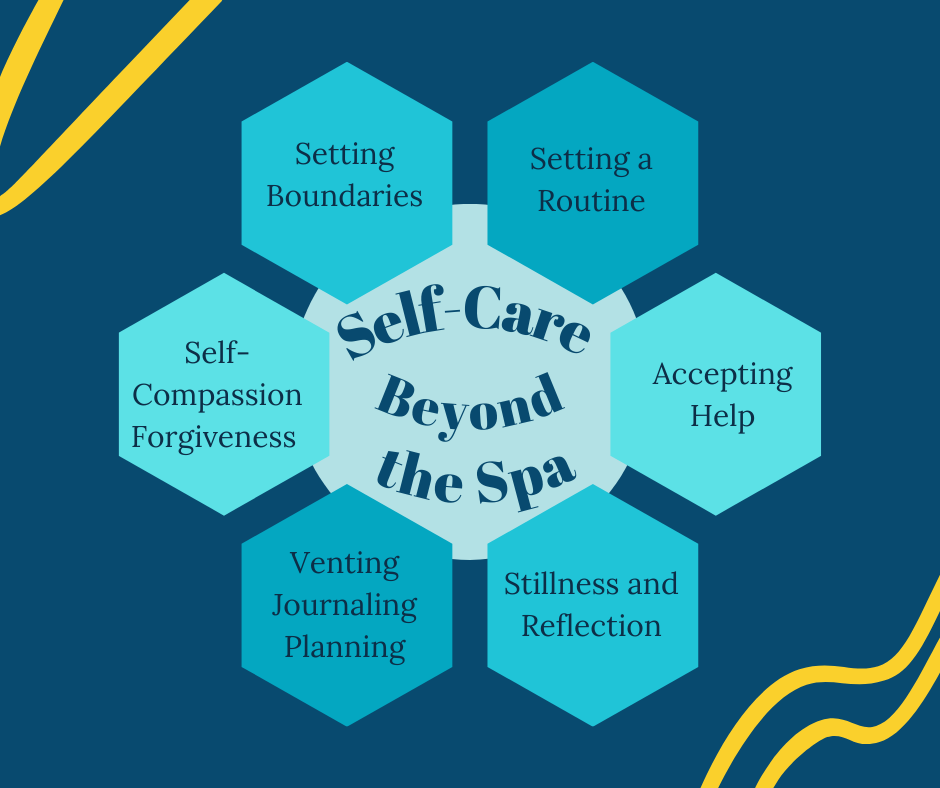September is Self-Care Awareness Month and the perfect opportunity to highlight that self-care is not selfish but rather a critical component of health. While it is easy to place our well-being behind the many responsibilities that pop up in a day, practicing self-care is crucial to our emotional and physical well-being. Therefore, when we juggle competing priorities it is important to discover self-care beyond the spa. Since it can be a slippery slope from helping out to burning out, awareness and intention can help us work self-care practices into our day which will slow and reverse the slide into the flames.
The reality is that self-care is much more inclusive than being pampered at a spa session or relaxing at a resort. There are many types of self-care. Self-care includes setting limits to protect our emotional or physical well-being or accepting help when needed. Acts of forgiveness are self-care when they free our hearts and minds making them lighter. Taking time to write in a journal is self-care. Walking in nature (physical self-care), conversing with a friend (social-self-care), or having a simple cup of tea are all meaningful self-care activities.
Self-care activities help you relax, re-energize, regroup, or reflect. A regular change of scenery, a change of head focus, or a change of heart focus can help prevent burnout when we have been giving too much of ourselves. Practicing self-care allows us to feel more in control of the chaos. When we prioritize self-care, we can better manage the uncomfortable emotions that arise when we are stressed and overwhelmed. Self-care cultivates resilience so we can meet the next challenge from a place of empowerment and strength.
Here are a few self-care practices you may not have thought of as self-care:
Setting Boundaries
Defining limits that protect our physical and emotional well-being is an act of mental self-care and a way of respecting and protecting ourselves and others.
Practicing Mindfulness
Cultivating awareness allows us to focus on the present rather than ruminate on the past or worry about the future. A few moments or more of stillness is an act spiritual of self-care.
Reimagining Self-Care
By practicing practical self-care, we can reimagine self-care activities into 5-, 10- or 15-minute blocks so that we can weave self-care into a busy schedule throughout the day.
Connect to Compassion
Staying connected to compassion, particularly self-compassion, plays a significant role in our sense of well-being. An act of self-kindness is emotional self-care.
Accepting our Situation
Even more important than accepting, embracing our challenges is what empowers us. Acceptance can seem passive on the surface, but it is an active self-care practice that can reduce stress and add meaning to your life’s journey.
Accepting Help
While there are many reasons why we resist help, receiving help is not only an act of self-care that will reduce stress but having help allows us to use the time and energy to focus on our well-being and add more self-care activities to our day.
Accepting Alternatives
Letting go is an act of self-care. When we let go of control, worries, expectations, and outcomes, we move into the flow, the current of life. Less resistance leads to less stress.
Transform Obstacles
We encounter obstacles daily, and obstacles make us emotional. Overcoming obstacles is empowering. Transforming them is next level and a tremendous act of self-care and self-empowerment.
Venting
When the emotions build like in a pressure cooker, it is crucial to release the frustrations and the worries. Venting to someone who gets it is an act of self-care.
Journaling
Writing out our problems is a form of venting and can help us process challenging or confusing experiences. Capturing our thoughts is an act of emotional self-care.
Forgiving
Forgiveness is a gift to us rather than the person we forgive and is a powerful act of emotional self-care. We may want to begin with forgiving ourselves and, from there, forgive others who may have disappointed us.
Planning
When we make a plan, it takes the worries out of the infinite loop in our minds and puts them on paper with a solution. Planning is an example of practical self-care, and just like venting, it helps clear the fog of worry and ruminating.
Setting a Routine
A routine will help you manage tasks, reduce stress, and feel accomplished. When we schedule self-care activities into a routine, they can be prioritized and protected with boundaries. Like accepting help, this is another double-dose act of self-care because establishing and embracing routines is not only self-care but enables you to maximize self-care opportunities.
For more on these self-care practices, subscribe and listen to the Self-Caregiving Strategies Podcast. If you are caring for a family member, you can read about how these self-care strategies can help you move from drowning to navigating in Navigating the Caregiver River: A Journey to Sustainable Caregiving, available on Amazon.
Schedule Theresa Wilbanks to speak on caregiving and empower the caregivers in your workplace or community with the 12 Sustainable Caregiving Strategies.
Advice offered is for general information only; please contact your healthcare team, legal or financial advisors to guide your particular situation.

